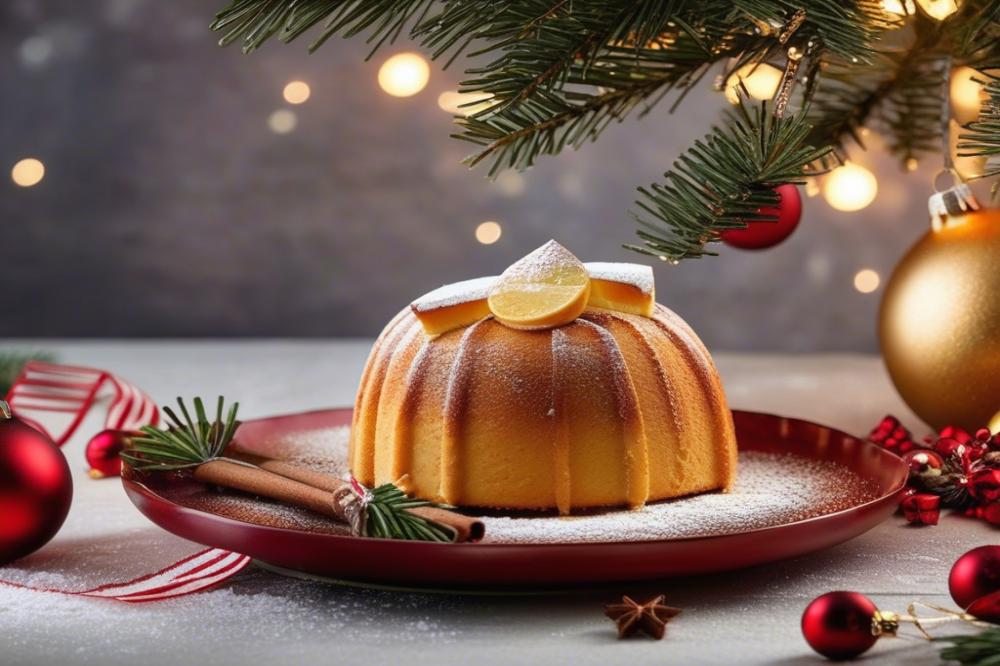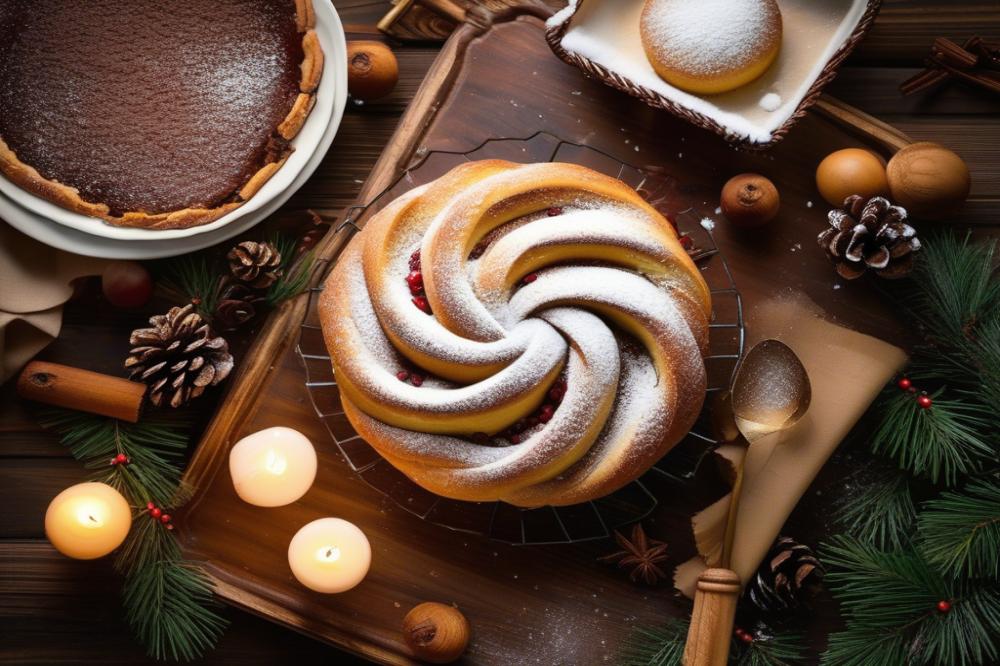Introduction
In Italy, there is a traditional dessert known for its rich flavors and festive spirit: Spongata di Natale. This Italian Christmas cake has deep roots in regional Italian cuisine. Families celebrate the holiday season with a variety of recipes, but few desserts hold as much significance as this one. It is not just food; it represents a connection to culture, history, and community.
baking this unique fruit and nut cake brings people together. The joy of preparing and sharing holiday treats is an important part of Christmas traditions across various regions in Italy. Each family often passes down their own Spongata recipe, which adds to the charm and individuality of every batch made.
Throughout the country, festive baking takes center stage during the Christmas season. Not only is the cake delicious, but it also showcases an array of ingredients that reflect local flavors. It serves as a sweet reminder of the past and a symbol of holiday cheer, making it a beloved staple in many homes. For those seeking an authentic taste of Italy, learning to make this Italian pastry can be both a delightful and meaningful experience.
History of Spongata di Natale

The origins of this traditional dessert can be traced back to Italy, where it has roots in the culinary practices of ancient times. In Roman and medieval kitchens, recipes often included fruits and nuts, which were readily available. Over time, these elements mixed with other regional flavors, leading to the creation of the fruit and nut cake known today.
Evolution and Variations Across Different Regions
As Italian cuisine evolved, so did the Spongata recipe. Each region added its own twist to the holiday treat. For instance, in Liguria, bakers might incorporate local honey and spices such as cinnamon and cloves. Meanwhile, in Emilia-Romagna, you might find a richer version, heavily relying on dried fruits. Differences in ingredients also reflect the local customs and resources available, which vary from one area to another.
Notably, the method of baking has also evolved. Traditionally, families would gather to prepare this Italian pastry during the Christmas season. Today, you might find it being prepared in kitchens across the world, with modern baking techniques often enhancing the ease of making this festive baking favorite.
Cultural Significance During Christmas
Spongata di Natale holds a special place in Christmas traditions across Italy. It is more than just a dessert; it represents family gatherings and the joy of the season. Sharing this cake during festive dinners is a long-standing practice. Each bite encapsulates the flavors of love, tradition, and celebration.
During the holiday season, this dessert brings people together. Families cherish the moments spent in the kitchen, passing down the Spongata recipe through generations. Beyond its rich taste, its cultural importance continues to grow, making it a beloved part of Italy’s festive baking heritage.
Ingredients List and Cooking Instructions

Ingredients needed for Spongata di Natale
- 500g all-purpose flour
- 200g unsalted butter
- 150g sugar
- 2 large eggs
- Zest of 1 lemon
- 1 tsp cinnamon
- 200g mixed dried fruits (figs, raisins, apricots)
- 100g nuts (walnuts or almonds)
- 1/2 tsp baking powder
- A pinch of salt
Cooking instructions step-by-step
Preparation of dough and filling
Start by melting the unsalted butter. Mix it with sugar in a large bowl. Add in the eggs one at a time, blending well after each addition. Incorporate the lemon zest and cinnamon. In another bowl, combine the all-purpose flour, baking powder, and a pinch of salt. Gradually mix the dry ingredients into the wet mixture until a dough forms.
Next, chop the dried fruits and nuts into small pieces. Combine them in a separate bowl. This mixture will be the filling for your Italian pastry. Blend the fruit and nut mix thoroughly to ensure an even distribution of flavors.
Assembling and baking the pastry
Preheat your oven to 180°C (350°F). Roll out half of the dough on a floured surface to form a thin layer. Transfer this layer to a baking dish. Spread the fruit and nut filling evenly over the surface. Roll out the remaining dough and place it over the filling. Seal the edges by pressing down firmly.
Cut decorative slits in the top layer to allow steam to escape during baking. Place the dish in the oven and bake for about 30-40 minutes, or until the top turns a lovely golden brown. After baking, let it cool before slicing.
This Spongata recipe is not just a treat but a slice of holiday traditions. Enjoy this festive baking as part of your Christmas recipe collection. It’s a delightful fruit and nut cake that embodies regional Italian cuisine and makes for wonderful holiday treats.
Nutritional Information

The Spongata di Natale is a delightful Italian pastry that combines fruits, nuts, and spices. Like many traditional desserts, understanding its nutritional breakdown is important. Each ingredient contributes to the overall calorie count and nutritional value.
Nutritional Breakdown of Each Ingredient
Common ingredients in this festive baking include flour, nuts, dried fruits, honey, and spices. Each plays a distinct role. For instance, one cup of all-purpose flour contains about 455 calories, primarily coming from carbohydrates. Nuts, such as walnuts or almonds, bring healthy fats and protein. Typically, an ounce of walnuts has around 185 calories, 18 grams of fat, and 4 grams of protein.
Dried fruits add significant sugars and energy. One-half cup of mixed dried fruits holds approximately 180 calories, with a notable sugar content of around 30 grams. Honey, another key ingredient, offers sweetness, with one tablespoon counting for about 64 calories and 17 grams of sugars.
Calories, Carbohydrates, Fats, Proteins, and Sugars
When analyzing the overall caloric content, you might find that a single slice of Spongata di Natale can range from 250 to 350 calories, largely due to the density of its ingredients. Carbohydrates make up the majority, primarily from flour and sugars in fruits and honey. Proteins come mainly from nuts, making this Italian pastry somewhat balanced.
Fats come from the nuts and any additional oils that may be used. Carefully choosing the types of nuts can enhance the health benefits. For example, almonds provide more Vitamin E than many other options. Sugars, from both natural sources like fruits and added ones like honey, contribute to the sweetness and energy.
Health Considerations Related to Traditional Desserts
When enjoying holiday treats like Spongata di Natale, moderation is essential. Traditional desserts often carry high sugar and calorie counts. However, they can also provide nutrients from fruits and nuts. Balancing these treats with a healthy diet can maximize enjoyment without feeling guilty.
Incorporating healthier ingredients into the Spongata recipe is an option. Using whole grain flour or reducing the quantity of added sugars can make a difference. Regional Italian cuisine often embraces fresh, natural ingredients, allowing for variations that enhance health benefits. Christmas traditions surrounding baking can also be an opportunity for family and friends to come together, making the experience fulfilling beyond just the nutritional aspects.
Serving Suggestions and Pairings
How to Serve Spongata di Natale
Serving this traditional dessert can be as delightful as baking it. Slice the Spongata into wedges, allowing guests to enjoy individual portions. Its rich flavors make it a perfect treat for gatherings. A dusting of powdered sugar can enhance its appearance, adding an elegant touch. Alternatively, warm slices could be offered alongside a scoop of vanilla gelato for an Italian twist. Present the pastry on a decorative platter, perhaps lined with seasonal greenery or edible flowers to celebrate the festive spirit.
Complementary Beverages
Pairing beverages with this Italian pastry elevates the entire experience. Vin santo, a sweet dessert wine, is a classic choice that complements the cake’s nutty flavors. Consider serving it in small glasses with a side of biscotti for a true Italian flair. Coffee also serves as a wonderful accompaniment, balancing the sweetness of the fruit and nut cake. A rich espresso or creamy cappuccino can provide a warm contrast, making your dessert even more enjoyable.
Presentation Ideas for Family Gatherings and Holiday Parties
When hosting holiday treats, presentation matters. Add seasonal decor like cinnamon sticks or orange slices around the dessert for a festive look. Use beautiful serving dishes that reflect the colors of Christmas, such as red and green, to draw attention to the Spongata recipe. For a fun activity, let family members assemble their slices with toppings like whipped cream or chopped nuts. These interactive elements can encourage conversation and laughter, embracing the essence of Christmas traditions. Finding ways to add personal touches will make the gathering memorable for everyone involved.
Spongata di Natale in Italian Culture
The Spongata di Natale is more than just a treat; it represents a rich tradition in Italian culture. Different regions celebrate this festive baking in their unique ways. For instance, in Emilia-Romagna, families often stick to traditional recipes that date back centuries. Meanwhile, in Liguria, variations may include different spices or additional fruits, showcasing the diversity of regional Italian cuisine.
Families take pride in their own methods of preparing this traditional dessert. Recipes are often passed down through generations. Each family may add their personal touch, whether with a specific fruit or a blend of nuts. During the Christmas season, the act of baking becomes a bonding experience. Everyone gathers to create these holiday treats, sharing stories and laughter along the way.
When comparing this fruit and nut cake to other Italian pastries, distinct characteristics emerge. For example, panettone is light and airy, while Spongata has a richer, denser feel. Both desserts are enjoyed during the holidays, but they cater to different tastes. Italian desserts, in general, often highlight seasonal ingredients, making them especially significant during festive times.
Local variations further enhance the experience. Northern regions may prefer a heavier emphasis on nuts, while southern recipes might lean more towards dried fruits. The Spongata recipe reflects the ingredients available in each area, indicating local agricultural practices. This also adds a layer of cultural significance, as families celebrate their heritage through baked goods each Christmas.
Wrapping Up the Joy of Baking Spongata di Natale
Baking this traditional dessert captures the essence of Italian holiday traditions. Each bite brings a story of family and celebration. The blend of rich flavors and textures offers a taste that feels like home. During Christmas, sharing this treat adds warmth to every gathering. Its unique characteristics make it a memorable addition to any festive feast.
Trying out this recipe not only honors tradition but also brings people together. It invites everyone to partake in the joy of cooking. Families can bond over the preparation process, creating lasting memories. Each step taken in the kitchen transforms simple ingredients into something beautiful. Your efforts will be rewarded with delicious results that everyone can enjoy.
Exploring more Italian pastry recipes can expand your holiday repertoire. Whether it’s classic Panettone or delicate Struffoli, there’s a world of flavors waiting to be discovered. Baking these treats will give joyous moments during the season. Tradition and flavor go hand in hand, making every recipe an adventure. Embrace the spirit of the holidays, and let your kitchen be filled with the joy of Italian craftsmanship.

